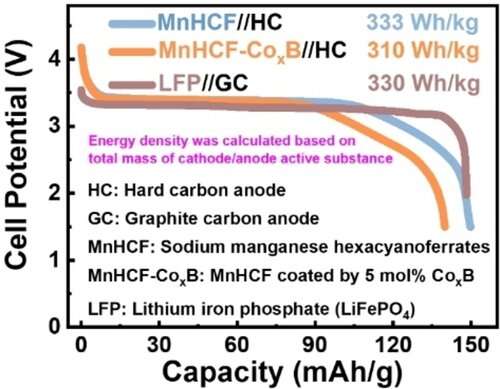This article has been reviewed according to Science X's editorial process and policies. Editors have highlighted the following attributes while ensuring the content's credibility:
fact-checked
peer-reviewed publication
trusted source
proofread
New method stabilizes rhombohedral sodium manganese hexacyanoferrates for high-energy Na-ion batteries

The rhombohedral sodium manganese hexacyanoferrates (MnHCF) is regarded as a scalable, low-cost, and high-energy cathode material for Na-ion batteries due to the absence of crystal water.
However, the unexpected Jahn-teller effect and significant phase transformation causes Mn dissolution and anisotropic volume change, leading to capacity loss and structural instability. Thus, it is important to build a robust and full coverage coating on the surface of MnHCF particles to address the cycling instability.
A research group led by Prof. Zhao Junmei from the Institute of Process Engineering (IPE) of the Chinese Academy of Sciences reported a simple room-temperature route to construct a magical CoxB skin on the surface of MnHCF, demonstrating thousands-cycle level cycling lifespan and high energy density close to LiFePO4 for Li-ion batteries.
The study was published in Angewandte Chemie International Edition on Jan. 31.
"Room-temperature-synthesized CoxB seems to be tailor-made as a coating substance of MnHCF cathode," said Prof. Zhao. "Meanwhile, CoxB is a metallic borate glass, and due to high corrosion- and wear-resistance, it shows good mechanical flexibility, which is expected to prevent the fracture or fragmentation of cathode particles."
Moreover, CoxB can work as a double conductor of mixed electrons and ions. These unique advantages make the optimal CoxB-coated MnHCF cathode (MnHCF-5%CoxB) deliver an initial capacity of ~133 mA h g-1 at 10 degrees C, higher than that of bare MnHCF (~110 mA h g-1).
More importantly, the coated samples can remain a capacity retention of over 80%, far superior to that of the pristine one (41%). In the full-cell configurations, the MnHCF-5%CoxB//HC delivers a high energy density of 310 Wh kg-1 based on the total mass of cathode/anode active substances, which is comparable to the commercial LFP cathode (~330 Wh kg-1).
"MnHCF-5%CoxB//HC shows an impressive capacity retention of ~71% at 5 degrees C after cycling 1,000 cycles, which is a significant breakthrough among the nonaqueous MnHCF full cells," said Prof. Zhao.
More information: Chunliu Xu et al, Surface Engineering Stabilizes Rhombohedral Sodium Manganese Hexacyanoferrates for High‐Energy Na‐Ion Batteries, Angewandte Chemie International Edition (2023). DOI: 10.1002/anie.202217761
Journal information: Angewandte Chemie International Edition
Provided by Chinese Academy of Sciences





















